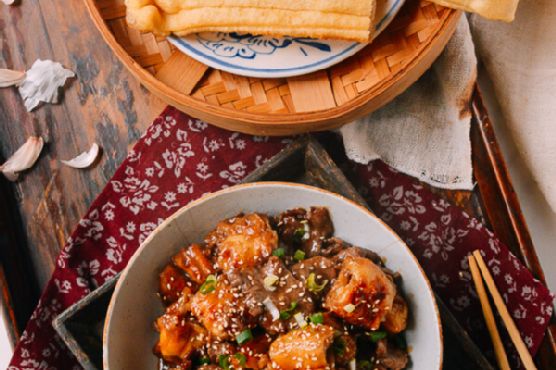Chickpea & Bulgur Stuffed Grape Leaves
Chickpea & Bulgur Stuffed Grape Leaves is a lacto ovo vegetarian recipe with 45 servings. For 26 cents per serving, this recipe covers 6% of your daily requirements of vitamins and minerals. One serving contains 43 calories, 2g of protein, and 2g of fat. This recipe is liked by 302 foodies and cooks. It works well as a hor d'oeuvre. If you have garlic, chickpeas, lemon zest, and a few other ingredients on hand, you can make it. From preparation to the plate, this recipe takes around 2 hours. It is brought to you by Eating Well. With a spoonacular score of 95%, this dish is spectacular. Users who liked this recipe also liked Grape Leaves Stuffed with Bulgur, Apricots and Mint (Yalancie Dolmas), Stuffed Grape Leaves, and Stuffed Grape Leaves.
Servings: 45
Preparation duration: 90 minutes
Cooking duration: 30 minutes
Ingredients:
3/4 cup bulgur (see Notes)
1 19-ounce can chickpeas, rinsed (about 2 cups)
1/2 cup finely chopped fresh parsley
7 cloves garlic, peeled and halved
1 15- to 16-ounce jar grape leaves (see Notes), drained
1/2 cup lemon juice, divided
Lemon wedges for serving
Zest of 1 lemon
2 tablespoons extra-virgin olive oil
1 teaspoon freshly ground pepper
Plain yogurt for serving
3/4 teaspoon salt
4 scallions, trimmed and finely chopped
1 tablespoon sumac (optional; see Notes)
3 tablespoons tahini (see Notes)
Equipment:
sauce pan
food processor
colander
tongs
bowl
kitchen towels
frying pan
pot
slotted spoon
Cooking instruction summary:
Put a large saucepan of water on to boil. Remove grape leaves from the jar and unroll. Separate into two pilesone of whole leaves and one with any torn leaves or pieces of leaves. The whole leaves will be used for rolling. Set aside the others for Step 5.Cook the whole grape leaves in the boiling water for 5 minutes; transfer with tongs to a colander to drain.To prepare filling: Process lemon zest and 1/4 cup juice, garlic, tahini, oil, sumac (if using), pepper and salt in a food processor until smooth. Scrape into a large bowl. Pulse chickpeas in the food processor until coarsely chopped. Add to the lemon mixture along with bulgur, parsley and scallions; mix until well combined.To assemble grape leaves: Lay a clean kitchen towel on a work surface. Place 4 to 6 whole grape leaves at a time on the towel with the stem-side up and stem end pointing toward you. Pinch or trim off any long or tough stems. Depending on the size of the leaf, shape 2 teaspoons to 1 tablespoon of the filling into a 1 1/2- to 2-inch log and place it on the leaf, perpendicular to the stem end. Roll the end of the leaf over the filling, tuck in the sides and roll tightly into a cigar shape. Repeat with the remaining grape leaves and filling. (You may have filling or grape leaves left over.)Place the torn or very small leftover grape leaves in a large saucepan, covering the bottom completely; this will prevent the stuffed leaves from sticking as they cook. (No leftover leaves? See Tip.) Place about half of the stuffed grape leaves in one tight layer in the pan and drizzle with 2 tablespoons lemon juice. Make a second layer of grape leaves on top of the first and drizzle with the remaining 2 tablespoons lemon juice.Place the largest heatproof plate you have that will fit in the pot on top of the grape leaves. Place a small-to-medium heatproof bowl on top of the plate and fill it three-quarters full with water (this will act as a weight to keep the grape leaves submerged). Add water to the pan until it reaches the rim of the plate.Timing: Bring to a boil, then reduce heat to a simmer. Cook until the bulgur is tender, adding water as necessary to keep the grape leaves submerged, about 30 minutes. (To check if the bulgur is done, carefully remove the bowl and plate, take out one stuffed grape leaf using a slotted spoon and cut it open.)Carefully remove the bowl and plate, then transfer the grape leaves from the water using a slotted spoon. Serve warm with lemon wedges and yogurt for dipping, if desired.
Step by step:
1. Put a large saucepan of water on to boil.
2. Remove grape leaves from the jar and unroll. Separate into two pilesone of whole leaves and one with any torn leaves or pieces of leaves. The whole leaves will be used for rolling. Set aside the others for Step 5.Cook the whole grape leaves in the boiling water for 5 minutes; transfer with tongs to a colander to drain.To prepare filling: Process lemon zest and 1/4 cup juice, garlic, tahini, oil, sumac (if using), pepper and salt in a food processor until smooth.
3. Scrape into a large bowl. Pulse chickpeas in the food processor until coarsely chopped.
4. Add to the lemon mixture along with bulgur, parsley and scallions; mix until well combined.To assemble grape leaves: Lay a clean kitchen towel on a work surface.
5. Place 4 to 6 whole grape leaves at a time on the towel with the stem-side up and stem end pointing toward you. Pinch or trim off any long or tough stems. Depending on the size of the leaf, shape 2 teaspoons to 1 tablespoon of the filling into a 1 1/2- to 2-inch log and place it on the leaf, perpendicular to the stem end.
6. Roll the end of the leaf over the filling, tuck in the sides and roll tightly into a cigar shape. Repeat with the remaining grape leaves and filling. (You may have filling or grape leaves left over.)
7. Place the torn or very small leftover grape leaves in a large saucepan, covering the bottom completely; this will prevent the stuffed leaves from sticking as they cook. (No leftover leaves? See Tip.)
8. Place about half of the stuffed grape leaves in one tight layer in the pan and drizzle with 2 tablespoons lemon juice. Make a second layer of grape leaves on top of the first and drizzle with the remaining 2 tablespoons lemon juice.
9. Place the largest heatproof plate you have that will fit in the pot on top of the grape leaves.
10. Place a small-to-medium heatproof bowl on top of the plate and fill it three-quarters full with water (this will act as a weight to keep the grape leaves submerged).
11. Add water to the pan until it reaches the rim of the plate.Timing: Bring to a boil, then reduce heat to a simmer. Cook until the bulgur is tender, adding water as necessary to keep the grape leaves submerged, about 30 minutes. (To check if the bulgur is done, carefully remove the bowl and plate, take out one stuffed grape leaf using a slotted spoon and cut it open.)Carefully remove the bowl and plate, then transfer the grape leaves from the water using a slotted spoon.
12. Serve warm with lemon wedges and yogurt for dipping, if desired.
Nutrition Information:
covered percent of daily need















